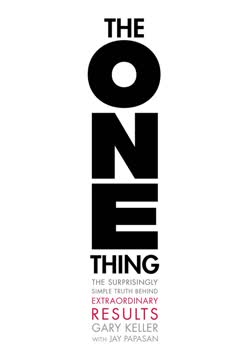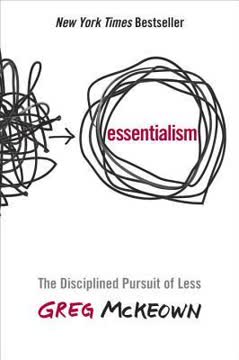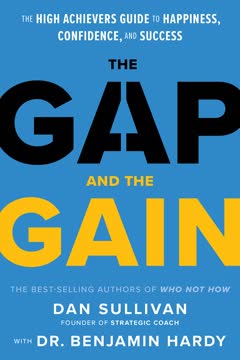重点摘要
1. 重新定义你的年度:12周,而不是12个月
12周年度为你设定了一个新的终点日期,以评估你的成功(或失败)。
打破年度思维的束缚。 传统的12个月年度常常导致拖延和缺乏紧迫感。通过将一年重新定义为12周,你可以创造一种紧迫感和专注力,推动行动。这种较短的时间框架允许:
- 更可预测的计划和执行
- 更加专注于关键优先事项
- 增强的责任感和动力
12周年度的概念消除了“年终冲刺”的心态,取而代之的是持续的高绩效。每12周成为一个新的开始,让你能够迅速适应和重新聚焦你的努力。
2. 为你的未来创造一个引人入胜的愿景
愿景是所有高绩效的起点。你先在心里创造,然后在现实中实现。
打造一个强大的个人愿景。 你的愿景是驱动你行动并帮助你克服障碍的情感燃料。要创建一个有效的愿景:
- 想象你在生活各个领域(个人、职业、财务等)的理想未来
- 使其具体、可衡量且情感上引人入胜
- 将你的短期目标与长期愿景对齐
一个强大的愿景提供了清晰度和动力,帮助你克服不适并坚持你的目标。定期回顾并与愿景联系,以保持专注和灵感。
3. 制定一个具有明确目标和行动的12周计划
一个有效的计划澄清并专注于实现愿景所需的首要举措和行动。
创建一个基于行动的计划。 你的12周计划应弥合愿景与日常行动之间的差距。要制定一个有效的计划:
- 为12周期间设定1-3个具体、可衡量的目标
- 确定实现每个目标所需的关键行动(策略)
- 在12周的时间框架内为每个策略分配截止日期
强大12周计划的关键要素:
- 具体且可衡量的目标
- 现实但具有挑战性的目标
- 清晰、可操作的策略
- 每项任务的个人责任
- 有时间限制的截止日期
记住,少即是多。专注于能带来最显著结果的关键行动。
4. 执行每周计划并评估你的表现
测量驱动执行过程。它是现实的锚点。
实施每周例行。 将你的12周计划分解为每周行动计划并评估你的执行情况。这个过程包括:
- 评估上周的表现
- 根据你的12周计划规划即将到来的一周
- 参加每周责任会议(WAM)
跟踪前导和滞后指标:
- 前导指标:采取的行动(例如,进行的销售电话)
- 滞后指标:取得的结果(例如,完成的销售)
目标是每周计划的执行率达到85%。这种一致性水平可能会导致实现你的12周目标。定期评估让你对自己的表现保持诚实,并允许及时调整。
5. 通过战略性时间块掌握时间管理
如果你不能控制你的时间,你就不能控制你的结果。
实施绩效时间。 这种时间分配系统帮助你有意地分配时间给高价值活动。三个核心组成部分是:
- 战略性时间块:3小时的不间断专注于重要但不紧急的任务
- 缓冲时间块:30-60分钟处理低价值活动和意外问题
- 突破时间块:3小时远离工作以刷新和恢复
创建一个包含这些时间块和其他关键活动的模型工作周。这种结构确保你将时间用于战略优先事项,同时有效管理日常任务。
6. 将责任感视为所有权,而不是后果
责任感不是后果,而是所有权。
转变对责任感的心态。 真正的责任感是对你的行动和结果负责,无论环境如何。为了培养更大的责任感:
- 决心不再成为受害者
- 停止自怜
- 愿意采取不同的行动
- 与“负责任的人”交往
责任感使你专注于你能控制的事情——你的思维和行动。通过接受这一原则,你增加了实现目标和创造理想生活的能力。
7. 做出并保持强有力的承诺
承诺是情感上或智力上绑定于某一行动的状态。
利用承诺的力量。 个人承诺和对他人的承诺都能带来显著的变化。要做出有效的承诺:
- 建立对结果的强烈渴望
- 确定将产生最大影响的关键行动
- 计算成本并愿意支付
- 根据承诺而不是感觉行事
对于对他人的承诺:
- 重视你的诺言及其履行(或违背)的影响
- 愿意说“不”以避免过度承诺
- 如果你意识到无法履行承诺,迅速重新协商
始终保持承诺建立自信,增强关系,并加速实现目标的进程。
8. 克服阻力并驾驭情感变化周期
每次完成周期,你不仅建立了能力,还建立了信心。
理解并准备面对阻力。 改变是不舒服的,你会面临内外障碍。常见的挑战包括:
- 对即时满足的需求
- 尝试一次性改变太多
- 根深蒂固的习惯和常规
- 受害者思维
要克服这些障碍:
- 将日常行动与引人入胜的愿景联系起来
- 一次专注于一两个关键目标
- 逐步建立新习惯
- 对你的选择和结果负责
认识到情感变化周期:
- 无知的乐观
- 知情的悲观
- 绝望的谷底
- 知情的乐观
- 成功和满足
通过预见这些阶段,你可以更好地驾驭挑战并坚持度过困难时期。记住,每次成功实施改变,你都在为未来的成长建立能力和信心。
最后更新日期:
FAQ
What's "The 12 Week Year" about?
- Concept Overview: "The 12 Week Year" by Brian P. Moran and Michael Lennington is about redefining the traditional annual planning cycle into a 12-week period, allowing individuals and organizations to achieve more in less time.
- Execution Focus: The book emphasizes the importance of execution over planning, suggesting that shorter time frames create a sense of urgency and focus that leads to better results.
- Systematic Approach: It introduces a structured system that includes setting goals, creating a 12-week plan, and measuring progress to ensure consistent execution.
- Personal and Professional Growth: The principles can be applied to both personal and professional goals, helping readers to improve their productivity and achieve their potential.
Why should I read "The 12 Week Year"?
- Increased Productivity: The book offers a proven method to significantly increase productivity by focusing on shorter, more intense periods of work.
- Goal Achievement: It provides a framework for setting and achieving goals more effectively, which can lead to personal and professional growth.
- Execution Over Planning: The emphasis on execution rather than just planning helps readers to take actionable steps towards their goals.
- Practical Tools: The book includes practical tools and strategies that can be immediately applied to improve time management and focus.
What are the key takeaways of "The 12 Week Year"?
- Redefine the Year: Treat 12 weeks as a year to create urgency and focus, leading to better execution and results.
- Vision and Planning: Establish a compelling vision and create a detailed 12-week plan to guide actions and decisions.
- Weekly Execution: Use weekly plans and scorecards to track progress and ensure consistent execution of critical tasks.
- Accountability and Commitment: Emphasize personal accountability and commitment to drive performance and achieve goals.
How does the 12 Week Year method work?
- Shortened Time Frame: The method involves breaking down the year into four 12-week periods, each treated as a separate year.
- Focused Planning: Each 12-week period starts with setting specific goals and creating a detailed plan to achieve them.
- Weekly Tracking: Progress is tracked weekly using scorecards to measure execution and adjust plans as needed.
- Continuous Improvement: After each 12-week period, results are reviewed, and lessons learned are applied to the next cycle.
What are the benefits of using the 12 Week Year system?
- Enhanced Focus: The system helps maintain focus on high-priority tasks by reducing the time frame for achieving goals.
- Improved Execution: By emphasizing execution over planning, it encourages taking consistent action towards goals.
- Greater Accountability: Regular tracking and review of progress increase accountability and drive performance.
- Flexibility and Adaptability: The system allows for quick adjustments and improvements based on feedback and results.
How do I set effective goals using the 12 Week Year?
- Align with Vision: Ensure that your 12-week goals align with your long-term vision and aspirations.
- Specific and Measurable: Set goals that are specific, measurable, and represent a realistic stretch for you.
- Focus on Few Goals: Limit the number of goals to maintain focus and increase the likelihood of successful execution.
- Action-Oriented: Break down goals into actionable steps and include them in your weekly plans.
What role does accountability play in the 12 Week Year?
- Ownership of Actions: Accountability is about taking ownership of your actions and results, regardless of circumstances.
- Peer Support: Engaging with a group for regular accountability meetings can significantly increase success rates.
- Self-Assessment: Regularly assess your progress and execution to identify areas for improvement and maintain focus.
- Commitment to Goals: Accountability reinforces commitment to your goals and helps overcome challenges and setbacks.
How can I improve my time management with the 12 Week Year?
- Time Blocking: Use strategic, buffer, and breakout blocks to allocate time for high-priority tasks and minimize distractions.
- Model Work Week: Create a model work week to plan and organize your time effectively around critical activities.
- Daily Focus: Start each day by reviewing your weekly plan to ensure alignment with your 12-week goals.
- Eliminate Low-Value Activities: Identify and reduce time spent on low-value activities to focus on what matters most.
What are the common pitfalls to avoid when implementing the 12 Week Year?
- Overloading Goals: Avoid setting too many goals, which can dilute focus and hinder execution.
- Neglecting Weekly Planning: Failing to plan weekly can lead to reactive behavior and reduced productivity.
- Ignoring Scorecards: Not tracking execution can result in missed opportunities for improvement and adjustment.
- Lack of Commitment: Without a strong commitment to the process, it's easy to revert to old habits and lose momentum.
What are the best quotes from "The 12 Week Year" and what do they mean?
- "Execution is the single greatest market differentiator." This quote emphasizes that success is determined by the ability to execute plans effectively, not just by having good ideas.
- "You are most effective when you are mentally where you are physically." It highlights the importance of being present and focused in the moment to achieve optimal performance.
- "Accountability is not consequences; it’s ownership." This quote redefines accountability as taking ownership of one's actions and results, rather than being about punishment.
- "The 12 Week Year changes everything!" It underscores the transformative power of adopting a 12-week execution cycle to achieve more in less time.
How can I apply the 12 Week Year to my personal life?
- Personal Vision: Start by creating a compelling personal vision that aligns with your values and aspirations.
- Set Personal Goals: Use the 12-week framework to set and achieve personal goals, such as improving health or relationships.
- Weekly Routine: Implement the weekly routine to track progress and maintain focus on personal priorities.
- Celebrate Successes: Use the end of each 12-week period to reflect on achievements and plan for the next cycle.
How does the 12 Week Year address resistance to change?
- Emotional Cycle of Change: The book outlines the emotional stages of change and provides strategies to navigate them effectively.
- Vision Connection: A strong vision helps overcome resistance by providing a compelling reason to push through discomfort.
- Structured Support: Tools like weekly plans and accountability meetings create a supportive environment for change.
- Focus on Execution: By emphasizing execution, the system helps individuals take consistent action despite resistance.
评论
《12周年》获得了褒贬不一的评价,评分从1星到5星不等。正面评价者称赞书中将年度目标压缩到12周的概念,认为这对提高生产力和实现目标非常有效。批评者则认为这本书内容重复,缺乏原创性,完全可以浓缩成一篇博客文章。一些读者欣赏书中关于计划和执行的实用建议,而另一些人则觉得信息过于基础和简单。几位评论者指出,这本书的效果取决于读者之前对生产力系统和目标设定技巧的经验。
Similar Books















